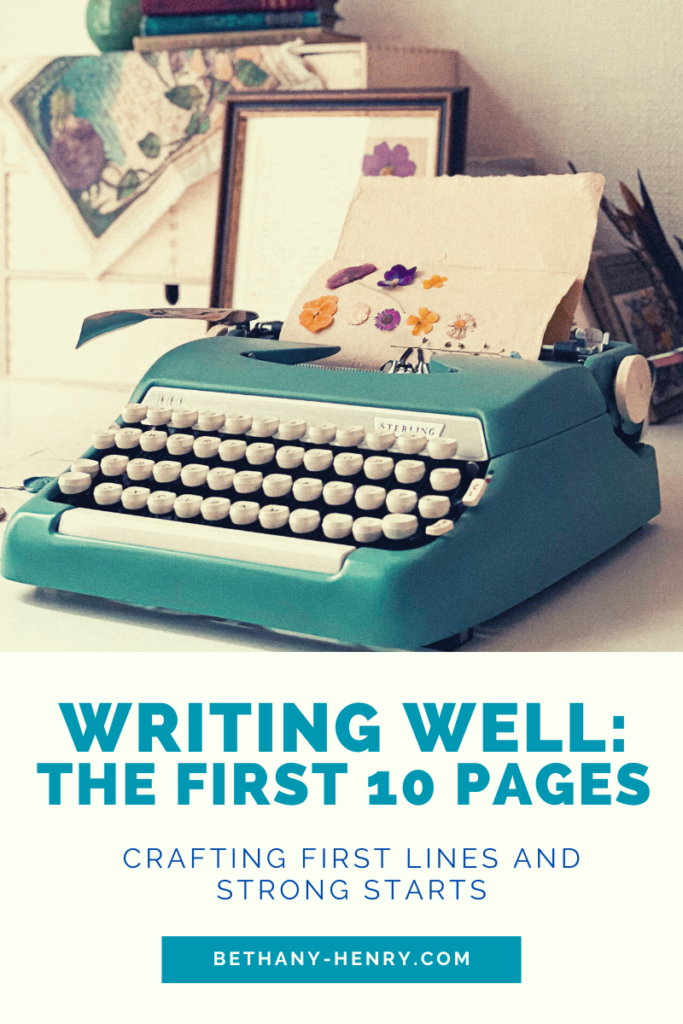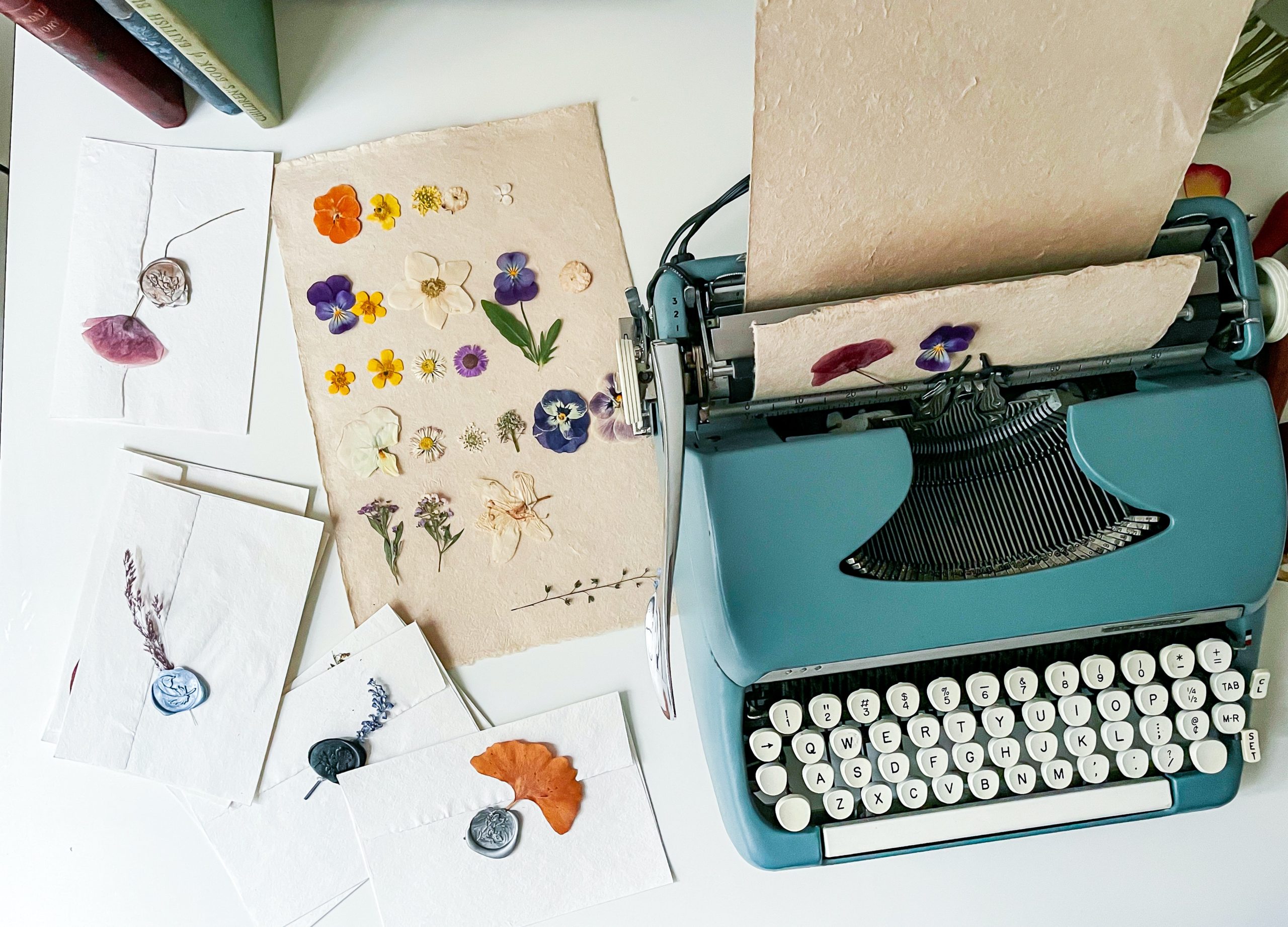
Earlier in the month we took a look at the importance of crafting satisfying endings to our story. Today we’re backtracking a bit to look at the story’s start!
The first page (and often the first sentence!) of our novel needs to hook our readers and introduce them to our story. It is critical that these initial paragraphs catch the readers’ attention and keep their interest.
Once they read past that first line, the next few pages play the important role of setting up the story, introducing our main character, and at least hinting at a problem. Each piece of our story should keep the reader interested (and reading).
Today we’ll break down strategies for crafting our first sentences and then look at how to structure our first pages.
Note: Most of this work is best done during the revision process! We don’t need to get it perfect right away.
It doesn’t make sense to agonize over the word choices of our first sentence in our first draft if it’s just going to be changed later.
If you’re just starting your draft, the best strategy is to get it done. Once it’s on paper, then you can come back here and think about the best strategies for revising it to perfection 🙂
Writing Well: The First Sentence
“An opening line should invite the reader to begin the story. It should say: Listen. Come in here. You want to know about this.”
Stephen King
The first sentence is the very first glimpse of our novel, the very first chance to hook our reader and introduce our story. No pressure or anything.
There are many different ways we could open our stories and it’s good to brainstorm and think through various possibilities. What are we trying to accomplish with our first words?
We may want to set a certain mood, introduce the main character, or raise a question.
And above all, we want to catch the reader’s interest. There are several different ways to do this so we’ll want to see what works best for our story!
3 Aspects Of A First Sentence
We don’t need to use all of these pieces but they can each be part of a powerful first sentence.
1. Question
Raising a question is the most powerful aspect of a first line.
This is where we introduce something strange or interesting enough that the reader wants to know more about it. They want answers to why.
And if they want to know more, they’ll keep reading.
We can raise a question through introducing an unexpected detail, like George Orwell’s novel 1984.
“It was a bright cold day in April, and the clocks were striking thirteen.”
George Orwell
Or we might raise a question by showing something is not how it should be, like in J.M. Barrie’s Peter Pan.
“All children, except one, grow up.”
J.M. Barrie
These first lines introduce a question that the reader will have to keep reading to discover the answer to.
Sometimes action can be used to achieve this end, such as by the character trying to escape from a burning building. However, life-or-death stakes aren’t enough to keep people reading because they aren’t emotionally invested in our characters yet. It doesn’t just need action, it needs to be interesting in some way to make the reader want to know more.
Questions keep people reading.
2. Imagery
Sometimes we may introduce our story by describing an important setting, main character, or item. For instance, the prologue at the beginning of the Lord Of The Rings movies focuses on introducing the one ring of power.
This imagery also tends to set up a certain mood for the story, like the epic fantasy backdrop for The Lord Of The Rings. This would be a very different story if we were describing a ring in a pre-teen’s glitter-coated jewelry box.
Whatever we choose to describe should be central to the focus and theme of our story.
This imagery can be combined with questions! Is this item more than it seems? Why is this world the way it is? Who is that person wearing a banana on their head?
3. Voice
Our first sentence can showcase our story’s tone and voice. This can set up our story and hook our readers, especially if the voice is particularly distinctive such as Lemony Snicket’s The Bad Beginning.
“If you are interested in happy endings, you would be better off reading some other book.”
Lemony Snicket
This not only introduces the story’s tone but it also raises questions, catching the reader’s interest.
Pro Tip: Keep It Simple
We don’t want to make our readers work too hard. (They may decide not to bother, and there goes our book!)
We don’t want to confuse them. We don’t want them to have to puzzle over what we are trying to say. Remember, they don’t already know (and love) the characters like we do!
Short, clear sentences (or even lists) are good for grabbing the reader’s attention and keeping them moving forward. A first sentence that is short and sweet can be perfect, even if it doesn’t include all of the elements above.
After all, the first sentence is just a set up for the next few pages…
For further reading check out 22 Of The Very Best First Lines Of Books.
Writing Well: The First 10 Pages
Once we’ve gotten someone reading our book, we have a lot of ground to cover in the first few pages. We need to set up the story, make the reader care, and of course keep the reader reading.
4 Things To Include In Our First Pages
Every story is a little different of course, but generally these elements are critical to introduce within the first few pages.
1. We need to introduce our main character.
Our protagonist(s) is a central part of our story and its plot. Introducing them early on marks them as important and enables the reader to start connecting with them.
We want our reader to care about our main character.
How we introduce a character will influence how our reader sees them.
We want readers to like our main characters to some degree- even if they are an “unlikable” or gray character. We don’t want our protagonist to be perfect by any means, the key is we want our reader to care enough to be interested in what happens to them.
Sometimes this can be done through a “save the cat” moment, where the protagonist has a chance to show kindness in the midst of their intro scene. Or the main character may be shown in some sort of sympathetic light, such as an underdog of some sort.
Regardless of how we introduce our main character, this is a piece that should occur at the start of our story.
2. We need to describe our setting/world.
As we begin our story, we need to ground our reader in the world its set in.
Whether that location is a fantasy world or the downtown Mom and Pop pizza joint, we want our reader to get a feel for the surroundings and be able to visualize the story.
If we don’t describe the setting at the start of our story then the reader may be confused or bored, since any action will be essentially happening in a blank or vague void. We the writer may have a great picture of what is happening but until we describe it to our readers they are left in the dark.
We don’t need to include all our worldbuilding details immediately (see Keep It Simple below!) but it is important to provide enough details so the reader can visualize the story.
3. Raise questions.
We want to hook our reader’s interest and make them want to find out what happens next.
This can be through introducing a goal or conflict of some sort, even something very minor such as Kurt Vonnegut’s famous example of a character wanting a glass of water.
Raising questions in our first pages is an extension of what we practiced with the first line of our story only now we have a little more room to work with. We can use interesting details or something unexpected or strange. And we can hint at our story’s central conflict or problems that will be introduced more fully later.
4. We need to set tone and expectations.
Every story will have a different feel to it.
The first pages should set the tone of our story. We are essentially making promises to the reader, communicating what type of book this is.
Often the genre we write in will contain certain expectations, for example a light-hearted cozy mystery romance will have different expectations than a gritty crime thriller.
If the reader can’t tell if this is a romance or a crime thriller, they may not continue reading because they don’t know what they are getting themselves into.
Now, book genres are a whole other topic. As are tone, voice, and theme. And there are exceptions to every rule, etc.
Regardless, the first few pages are important for establishing the tone and expectations of our story so that the reader will not only keep reading, but ultimately be satisfied with its conclusion.
Pro Tip: Keep It Simple
Sound familiar? 🙂
Again, we want to make it as easy as possible for the reader to keep reading.
This means we need to avoid infodumps.
Does the reader really need to know all of a character’s backstory immediately? Do they need to meet every single character in the first scene? No and no.
If we introduce all our characters all at once, the reader will forget who is who. And if we present information too quickly, the reader has no reason to care about its significance and they may be both bored and confused. Not really what we’re going for.
We need to skip the slow parts.
There is no room for being bored in a story, and that goes doubly so for the first few pages. We don’t want to give the reader any excuses to set the story aside.
Avoid prologues if possible.
There are many opinions on this and you can make your own decisions for your own stories. However, it is worth being critical of our prologues as we craft the first ages of our story.
Prologues often serve as infodumps and tend to bore readers by starting before the “real” action begins. Even if a reader enjoys the prologue, we then have to “hook” them again to keep them interested in the story itself.
While they aren’t inherently always bad, they rarely offer significant payoff for the prime real-estate they require at the very beginning of our story.

The key to all of this is that we want the reader to keep reading. That’s it! It’s that simple and it’s that hard 🙂
Take a look at some of your favorite books. How do they start? What do you like (or dislike) about their first lines and pages?
For further reading:
10 Things Your Opening Chapter Should Do: A Check-List For Self-Editing
Planning Your Stories Opening Passages
Happy writing to you today! 🙂




